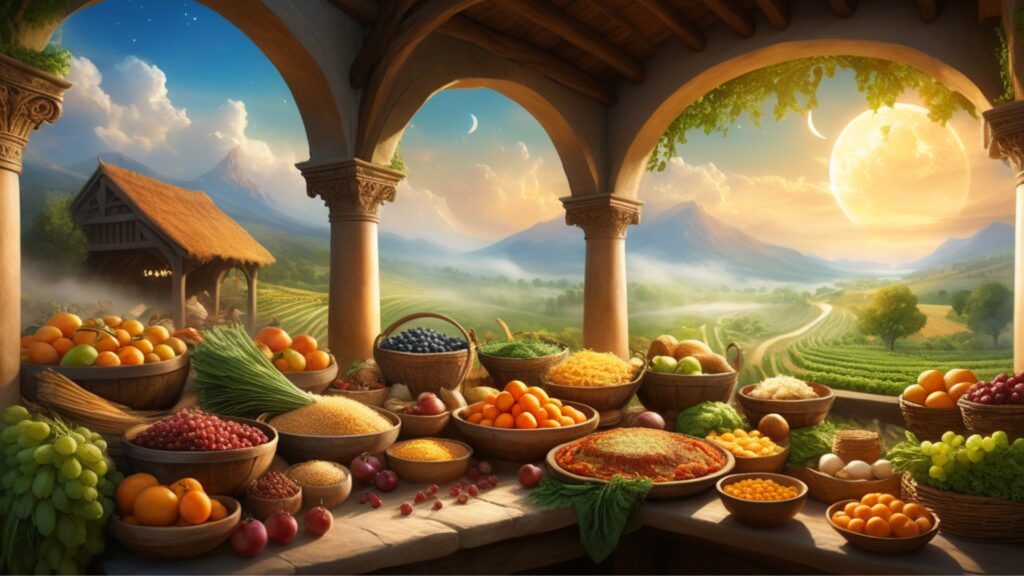
It’s easy to forget the profound connection between freedom and creation that our ancestors may have had more the experience to appreciate. The act of transforming simple ingredients into nourishing meals was, for them, a celebration of life’s offerings. Ancient culinary traditions have imprinted adaptions in us through time, from the fields and forests, to our forebearers hearths and tables. In rediscovering the savoring foods of past necessity, we find them nourished with intrinsic values that enrich freedom.
The Wisdom of Ancient Cooking
In the eyes of our ancestors, cooking was more than a chore—it was a sacred art. From the nomadic tribes of the Sahara to the empires of Asia, every culture developed unique culinary traditions deeply intertwined with their environment and way of life. The diets of our forefathers were enriched by the abundance of whole foods in their environment, nourishing their bodies and fortifying their connection to the natural world. These ancient cooks understood the essence of freedom through creation—taking raw ingredients and transforming them into nourishment, forging connections within communities, and celebrating the bounty of Earth.
Ancient Eating for Vitality and Survival
Our ancestors’ diets were a testament to the profound connection between food and vitality. In a world where every morsel mattered, they embraced holistic whole foods that nourished their bodies and sharpened their survival instincts. Their diets were rich in locally sourced, unprocessed ingredients—fresh vegetables, lean meats, and foraged plants, providing essential nutrients that fueled their physical resilience. One such ancient meal, reminiscent of past nourishing traditions, is a hearty “Roots and Game Stew.” This stew combines game meat with seasonal vegetables, and herbs, offering a taste of primitive times while providing a wholesome and balanced meal. The benefits of preparing such a dish today extend beyond the palate to our overall health, as it aligns with the principles of whole-food nutrition, offering a spectrum of vitamins, minerals, and protein that energize the body and nourish the spirit.
Traditions of Animal Husbandry
Historic protein sources were as diverse as they were sustainable. Our ancestors, keenly attuned to their environments, often turned to local and readily available options. The tradition of raising hens for eggs flourished in various regions, providing a versatile and nutritious source of protein. Additionally, goats, cow and pigs have long been raised for meat, milk and various cheeses, crafted with skill and patience, gracing the tables of many ancient civilizations. Fish farming was a practice that resonated with coastal communities, offering a reliable source of protein. They cultivated fish in carefully designed aquaculture systems, fostering the growth of species like tilapia and catfish. Fish farmers of ancient civilizations may have harvested caviar from species like sturgeon for its exquisite taste and nutritional richness, recognizing its benefits as a delicacy that provided essential fats and proteins to their diets. These practices not only ensured a steady supply of protein but also contributed to the sustainability of aquatic ecosystems. Embracing these time-tested methods, we inherit the foresight for future survival.
Ancient Roots and Game Stew Recipe
This ancient-inspired stew offers a plethora of benefits for the modern diner. The game meat provides lean protein, essential for muscle health and overall vitality. The medley of root vegetables delivers a spectrum of vitamins and minerals, including vitamin A, vitamin C, and potassium, while the fresh herbs add depth of flavor and additional health benefits. Savoring this meal, we connect with the time-honored tradition of whole-food nutrition to nourish our bodies, invigorate our senses, and align with a natural approach to food that has sustained generations.
Ingredients:
- 1 lb game meat (venison, rabbit, or lean beef as a substitute)
- 4 cups mixed root vegetables (carrots, parsnips, turnips)
- 1 onion, chopped
- 2 cloves garlic, minced
- 4 cups beef or vegetable broth
- 2 sprigs of fresh thyme
- 2 bay leaves
- Salt and pepper to taste
- Olive oil for cooking
Instructions:
- In a large, heavy-bottomed pot, heat olive oil over medium-high heat. Add the chopped onion and minced garlic and sauté until fragrant and translucent.
- Add the game meat and sear until browned on all sides. Season with salt and pepper.
- Add the mixed root vegetables, thyme sprigs, and bay leaves to the pot.
- Pour in the broth, ensuring that the ingredients are mostly submerged. Bring the mixture to a boil.
- Reduce the heat to low, cover the pot, and let the stew simmer for 1-1.5 hours, or until the meat is tender and the vegetables are soft.
- Remove the thyme sprigs and bay leaves before serving.
Other Ancient Recipes to Savor the Past
1. Mediterranean Olive Oil Bread: Transport yourself to the sun-drenched shores of the Mediterranean with this ancient recipe for olive oil bread. A simple blend of flour, water, salt, and olive oil, this bread captures the essence of freedom in its rustic simplicity.
2. Aztec Chocolate Elixir: Dive into the world of the Aztecs with a rich and decadent chocolate elixir. Made from cacao, chili peppers, and spices, this ancient beverage is a testament to the Aztec appreciation for the culinary arts. The history of chocolate in Mesoamerica, has a sacred role in Aztec culture, and the simple joy of sipping a timeless elixir that embodies an indulgence in life’s pleasures.
3. Kimchi: Explore the ancient art of fermentation with the vibrant and spicy Korean dish known as kimchi. This traditional side dish is made from a variety of vegetables, most commonly napa cabbage and Korean radishes, combined with a flavorful mixture of ingredients like garlic, ginger, and red pepper flakes. After being seasoned and left to ferment for a period, kimchi develops complex flavors and a distinctive tang. Its popularity endures to this day as a beloved staple in Korean cuisine and has gained recognition worldwide for its probiotic benefits and unique taste. Savoring kimchi connects us with a time-honored method of food preservation while enjoying the nutritional advantages of fermented foods, elevating our overall health and well-being.

Rediscovering Freedom in Culinary Creation
From the utilization of local and seasonal ingredients to the communal aspect of sharing meals, the insights from our culinary ancestors offer a path to a more sustainable and fulfilling way of life. Embarking on a culinary journey through ancient traditions, may you savor the freedom that comes from creating nourishment with your own hands and connecting with the timeless wisdom of heritage. In the act of transforming simple ingredients into memorable meals, a profound sense of freedom, creativity, and a deeper connection to the Earth and its bounty is nourished.



